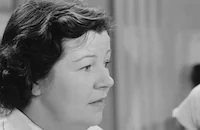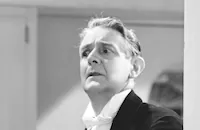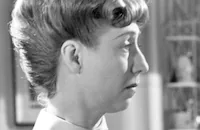My Dear Miss Aldrich

Brief Synopsis
Cast & Crew
George B. Seitz
Edna May Oliver
Maureen O'sullivan
Walter Pidgeon
Rita Johnson
Janet Beecher
Film Details
Technical Specs

Synopsis
When Thomas Hobson, publisher of the New York Globe-Leader , dies without leaving a will, the paper reverts to his niece, Martha Aldrich, a schoolteacher from Nebraska. Ken Morley, the woman-hating managing editor of the Globe-Leader , is not looking forward to a woman boss, especially as he is busy working on a big story about the possible pregnancy of a visiting European queen. Impressed to find that Martha is an attractive young woman, Ken accompanies Martha and her aunt, Mrs. Lou Atherton, to spend the weekend at ex-Governor Warfield's home. While Aunt Lou works on newspaper puzzles, Martha works on Ken, trying to convince him to reverse his policy against hiring women. A few days later, when she boldly calls the queen to ask if the rumors are true, she confirms the pregnancy and lands an interview as well. When Martha officially takes ownership of the paper, Ken has "the boys" dress up themselves and the city room to make fun of her, but she ignores the swipe and asks for a job as a reporter. Despite his views on women reporters, Ken agrees, partially because he has fallen in love with her. Later, when Warfield's daughter Ellen asks Martha to be a witness at her secret marriage to Chronicle editor Gregory Stone, and the scoop is only printed in the Chronicle , Ken angrily fires her. Consoling herself by buying a hat, Martha sees Mrs. Sinclair, who with her husband is an important labor leader about to initiate a strike against industrialist Talbot, and gets a hunch about a secret settlement. She goes to Mrs. Sinclair to get a story but, though Mrs. Sinclair is sympathetic to the plight of woman reporters, she tells Martha nothing. Later, Martha sees the Sinclairs sneak out of their apartment and follows them to the Red Apple Inn in Fort Lee, where they and Talbot are secretly ratifying a new labor contract. While Ellen tries to get her story by hiding in a dumb waiter, a worried Ken and Aunt Lou discover where she has gone and follow her with reporter Ted Martin. Angered when she realizes that Martha actually owns the Globe-Leader , Mrs. Sinclair ties her up and decides to give the story only to the Chronicle . When Ken, Ted and Aunt Lou break in, they, too, are tied up. After using the mirror from her compact to untie their bonds, Martha and Ken sneak out and plant the story while Aunt Lou pretends to have small pox and the restaurant is quarantined by some of Ken's reporters posing as ambulance attendants. Finally realizing that they work well together as a team, Ken proposes that she stay on as a reporter and as his wife, and she happily agrees to both propositions.

Director
George B. Seitz
Cast

Edna May Oliver

Maureen O'sullivan

Walter Pidgeon

Rita Johnson

Janet Beecher

Paul Harvey
Charles Waldron

Walter Kingsford
Roger Converse

Guinn Williams

Leonid Kinskey
Brent Sargent

J. Farrell Macdonald
Robert Greig
Harry Tyler
Jack Norton

Lya Lys
Renie Riano
Billy Wayne
Leonid Snegoff
Don Barclay
Carl Stockdale

E. Alyn Warren

James Flavin
Selmer Jackson
Edward J. Le Saint
William Norton Bailey
Sunny Bupp

Margaret Bert

Leonard Carey
George Noisom

Gwen Lee
Marcelle Corday
Hal Le Suer
Ralph Bushman
Wally Maher
Clive Morgan
Paul Newlan
Arthur Belasco

Marie Blake
Adia Kuznetzoff
Garry Owen
George Davis
Bud Fine
Jack Baxley
Crew
E. J. Babille
Randall Duell
Cedric Gibbons
William S. Gray
Charles Lawton Jr.
Herman J. Mankiewicz
Douglas Shearer
David Snell
Dolly Tree
Edwin B. Willis

Film Details
Technical Specs

Articles
My Dear Miss Aldrich
by Glenn Erickson

My Dear Miss Aldrich
Quotes
Trivia
Notes
A Hollywood Reporter production chart on July 19, 1937 incorrectly identified actor Walter Pidgeon as Arthur Pidgeon. According to a news item in Hollywood Reporter, Pidgeon was borrowed from Universal for the picture, but subsequent to its completion, he was put under contract to M-G-M.















